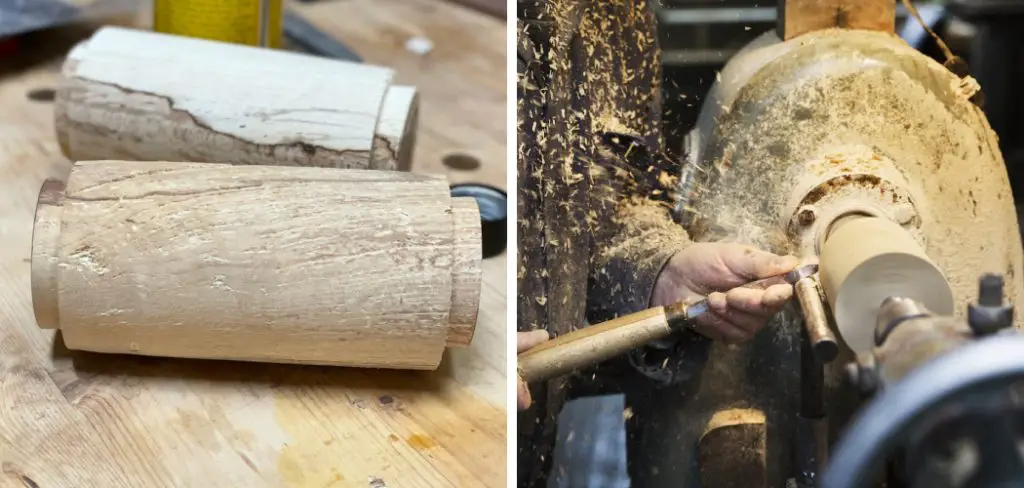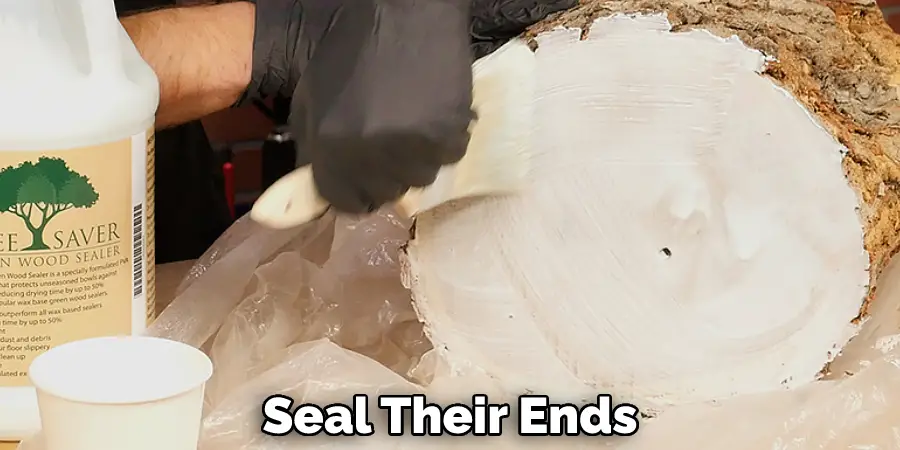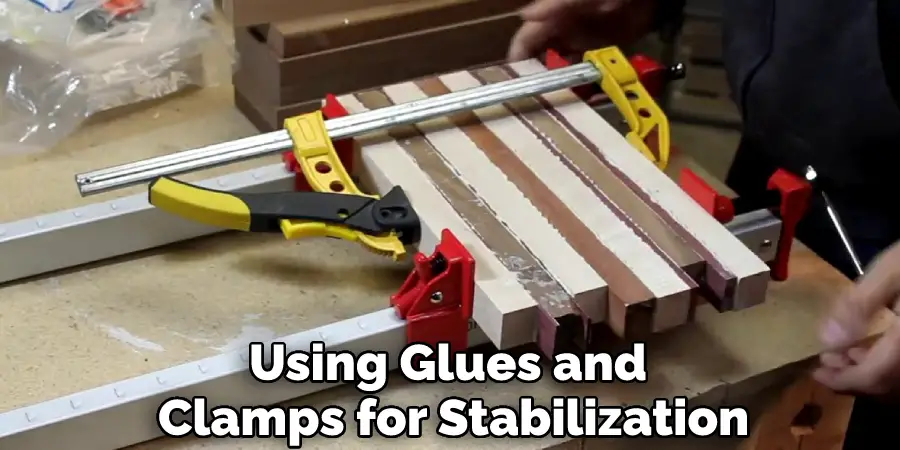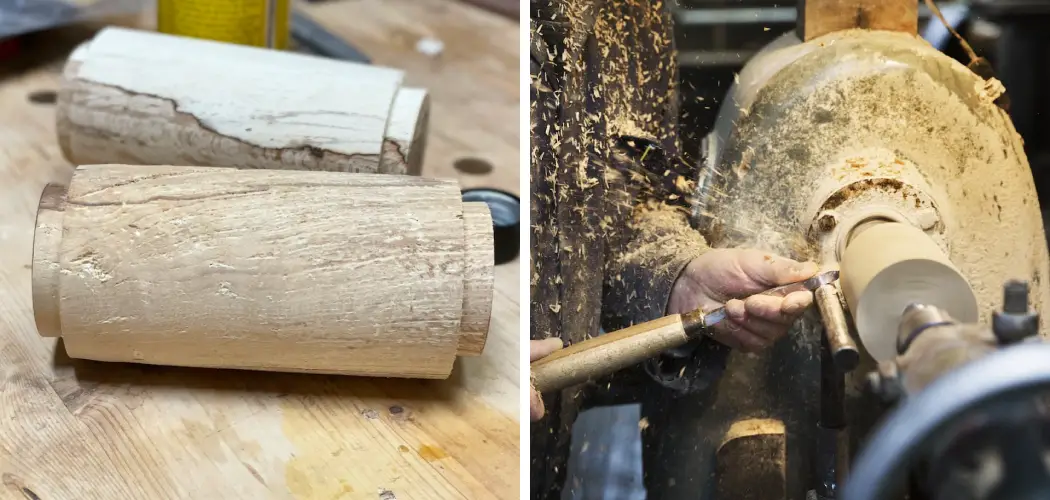Woodturning is a great hobby that people of all ages can enjoy. It’s a great way to use scrap wood, and you can create some amazing art pieces. However, if the wood isn’t stabilized, it can warp and crack while you’re turning it. In this blog post, we’ll show you how to stabilize wood for turning so that your projects turn out perfectly every time. Stay tuned!

Summary: There are a few ways to stabilize wood for turning. One is to use a block of wood or a dowel to keep the piece of wood stable while you turn it. Another is to clamp the wood down in a vise or other type of holding device.
Why Stabilize Wood?
Woodturners often stabilize wood because it helps prolong their work’s life. By stabilizing the wood, you’re giving it a preservative treatment that will help prevent cracking, warping, and other forms of deterioration. This is especially important if you plan on selling your work or if you want to be able to enjoy it for many years to come.
There are two main ways to stabilize wood: chemically and physically. Chemical stabilization generally involves injecting the wood with some kind of resin or other preservative substance. On the other hand, physical stabilization involves sealing the wood with a vacuum chamber so it can’t absorb moisture from the air (also known as kiln drying).
7 Steps to Follow on How to Stabilize Wood for Turning
Step 1: Choosing the Right Wood
The most important step in stabilizing wood is choosing the right wood in the first place. As we mentioned before, some woods are more stable than others. For example, hardwoods like maple and oak are usually quite stable, while softer woods like pine tend to be less stable. If you’re unsure whether or not a particular type of wood is suitable for stabilization, ask your local lumberyard or woodturning supplier for advice.
Step 2: Cut the Wood Into Blanks
Once you’ve chosen the right wood, the next step is to cut it into blanks. For stabilization purposes, it’s best to use at least 6″ long and 3″ wide blanks. Ideally, they should also be as thick as possible, although this isn’t always practical.
Step 3: Seal the Ends of the Blanks
Once the blanks are cut, the next step is to seal their ends. This will prevent them from drying out too quickly and cracking during the stabilization process. There are a few different ways to do this, but one of the simplest is simply to dip each blank’s end in boiled linseed oil.

Step 4: Vacuum Pack the Blanks
Once the ends of the blanks are sealed, it’s time to vacuum pack them. Vacuum packing is an important step in stabilization because it helps to remove all the air from around the wood, which prevents it from drying out too quickly. You’ll need a vacuum sealer and some heavy-duty plastic bags to vacuum pack the blanks. Simply place the blanks in the bags and then use the vacuum sealer to remove all the air.
Step 5: Freeze the Blanks
After the blanks are vacuum-packed, the next step is to freeze them. This may seem counterintuitive, but freezing actually helps to stabilize wood by preventing it from drying out too quickly. To freeze the blanks, simply place them in a freezer for 24 hours.
Step 6: Vacuum Dry the Blanks
After the blanks have been frozen, the next step is to vacuum dry them. Vacuum drying is different from regular drying because it removes all the air around the wood, preventing it from drying out too quickly. You’ll need a vacuum sealer for this step.
First, seal the blank in a plastic bag to vacuum dry the wood. Then attach the vacuum sealer to the bag and turn it on. The vacuum will remove all the air from the bag, and the wood will start to dry out.
Step 7: Store the Blanks
Once the blanks are dry, the final step is to store them. The best way to do this is to wrap them in wax paper or freezer paper and then put them in an airtight container.
That’s it! These seven steps will show you how to stabilize wood for turning. Just remember to choose the right wood, cut it into blanks, seal the ends, vacuum pack it, freeze it, vacuum dry it, and then store it properly.
What You Need to Know About Stabilize Wood for Turning
Turning wood on a lathe can be an incredibly satisfying experience, and it’s a great way to produce beautiful and unique pieces of art. First, however, it’s important to stabilize the wood before you start turning. This process helps prevent the wood from warping or cracking and makes it easier to turn. There are a few different methods that can be used to stabilize wood, but one of the most effective is to soak it in denatured alcohol.

This will penetrate deep into the wood, and it will help to prevent the fibers from moving. In addition, once the wood is dry, it will be much more stable and easier to work with. As a result, stabilization is an essential first step for anyone who wants to produce high-quality turned wood.
How to Stabilize Wood for Turning with A Lathe
Any woodworker knows that a lathe is only as good as the wood you put into it. To produce smooth, consistent results, the wood must be properly stabilized. The first step is to adjust the humidity levels in your workshop. Wood is an organic material that will expand and contract in response to changes in temperature and humidity. By keeping the humidity levels in your workshop stable, you can minimize the amount of movement in the wood.
Next, you must select the right wood type for your project. Some woods are naturally more stable than others, and they will produce superior results when turned on a lathe. Finally, you can stabilize the wood using a sealer or stabilizing resin. These products help to fill in any cracks or voids in the wood, making it less likely to warp or split during turning. By following these simple steps, you can ensure that your wood is properly stabilized and ready for turning on a lathe.
How to Use Various Types of glue and Clamps for Stabilization
While there are various ways to stabilize an injury, glues, and clamps are often the best option. Glues work by creating a dried, hardened barrier over the wound. This can help to keep out infection while the body heals itself. On the other hand, clamps work by holding the skin together with steady pressure.
This can be helpful for deep cuts or gaping wounds. However, there are a few things to remember when using glues and clamps for stabilization. First, make sure that the area is clean and free of debris. Second, apply the glue or clamp as directed. Third, do not remove the glue or clamp until it is time to do so. By following these simple instructions, you can ensure that your injury heals properly.

Choosing the Right Stabilizing Method for Different Wood for Turning
Stabilize Wood is a versatile material that can be used for various tasks, from construction to furniture making. However, wood is also susceptible to warping and deterioration over time. One way to help prolong the life of your wooden products is to choose the right stabilizing method. For example, if you are working with softwood such as pine, you may want to consider using a resin-based stabilizer. This will help to fill in any voids in the wood and prevent further damage.
Alternatively, if you are working with a hardwood such as oak, you may want to consider using an epoxy-based stabilizer. This will create a stronger bond between the wood fibers and help to prevent cracking and splitting. By taking the time to choose the right stabilizing method, you can help ensure that your wooden products will last for years to come.
Troubleshooting Common Stabilization Problems
When woodturning, choosing the right stabilizing method is essential to ensure that your piece does not warp or crack. For example, for denser woods such as maple or oak, you will need to use a stronger method such as cyanoacrylate. This type of glue creates a strong bond that can stand up to the high pressures exerted by the lathe.
In contrast, for softer woods such as pine or poplar, you can get away with using a less invasive method such as vacuum stabilization. This involves using a vacuum chamber to remove air bubbles from the wood, which helps to prevent cracking and warping. Again, understanding the different types of wood and their stabilization needs can ensure that your wood-turning projects are successful.

What is the Cheapest Way to Stabilize Wood?
Stabilizing wood is a process where resin is infused into the wood fibers to strengthen and harden it, preventing it from warping, cracking, or shrinking. The cheapest way to stabilize wood involves using a homemade stabilizing solution consisting of polyurethane resin and acetone.
To prepare the solution, mix the polyurethane resin and acetone in a container in a ratio of 1:1. The acetone acts as a thinner, reducing the viscosity of the resin and making it easier to penetrate deep into the wood fibers.
Next, immerse the wood in the solution, ensuring that it is completely submerged for at least 30 minutes. The viscosity of the solution allows it to penetrate deep into the wood fibers, filling any voids or cracks.
After the wood has been soaked in the solution, remove it and let it air dry for at least 24 hours in a well-ventilated area. The acetone evaporates, leaving the resin behind to harden and cure, resulting in a strong, stable piece of wood.
Do You Have to Stabilize Wood for Turning?
Yes, it is highly recommended to stabilize wood for turning as it can prevent cracking or warping during the turning process. The process of stabilizing wood involves impregnating the wood with a stabilizing agent that fills the pores and cavities within the wood, making it more durable and resistant to changes in atmospheric conditions. This prevents moisture from penetrating the wood, which can cause it to expand, contract, and ultimately crack.
Stabilizing the wood also enhances its color and grain patterns, making it more aesthetically pleasing. There are several useful techniques that can be used to stabilize different types of wood, including resin stabilization and vacuum stabilization. Stabilizing the wood before turning can produce high-quality and long-lasting wooden objects like utensils, bowls, vases, and other decorative items.
Conclusion
Stabilizing wood is an important step in any turning project. By taking the time to stabilize your material beforehand, you’ll be able to avoid many common issues like warping and cracking. Epoxy resin and CA glue are great options for stabilizing wood; just let them dry completely before starting your project! Thanks for reading our post about how to stabilize wood for turning.

